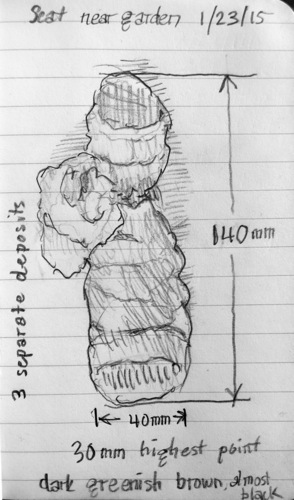Yesterday, Carol noticed some scat and other mammal signs in our garden. First, something has been eating the tree kale Carol has been growing. The bitten-off leaves and stems are some 425 mm / 17 inches from the ground:

This seems a little high off the ground for rabbits. According Jameson and Peeters Mammals of California, the rabbit most likely to be found in our area is Audubon’s Cottontail (Sylvilagus audubonii). The total length, from nose to tail, of Audubon’s Cottontail is 370-400 mm, or about 15 inches; it would be a stretch (but possible) for a rabbit that size to reach up 425 mm to nibble on stems and leaves.
Right next to the tree kale is a deposit of scat: many small pellets, all about 5-7 mm in diameter. This, according to Olas Murie in A Field Guide to Animal Tracks would be absolutely typical of cottontails. But it may be coincidence that there’s a deposit of cottontail scat right next to the bitten-off twigs, and it could be that a deer got into our yard; Carol has seen deer down the cul-de-sac on which we live, and we suspect that they move up and down San Mateo Creek, which is less than a block from our house.
There’s another scat right next to another of our garden beds. Here’s my sketch of it:

The lack of taper on the ends, and the relatively large size, leads me to believe that these are raccoon scat. Murie says that raccoon scat can be difficult to identify, and “may be confused with the larger skunks and opossum.” But given the size — on the large size for raccoons, probably too big for skunks or opossums — and the fact that we regularly see raccoons at night in our garden, I’m going to guess this is from a raccoon.

Could it be a hare instead of a rabbit?
Jameson and Peeters show the range of hare species in California as restricted to the Sierras, so I’m guessing not. Another possibility to consider is the Black-tailed Jackrabbit (Lepus Californicus). Murie lacks data on the size of jackrabbit pellets, but Whitaker and Hamilton, Mammals of the Eastern United States (3rd ed., 1998) gives the size of jackrabbit pellets as 13 mm, substantially larger than these pellets. So I keep coming back to Audubon’s cottontail as my best guess.